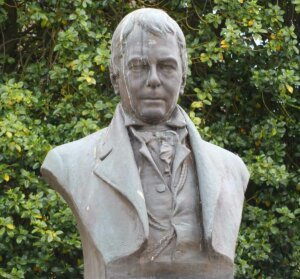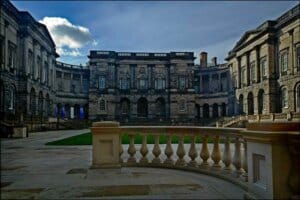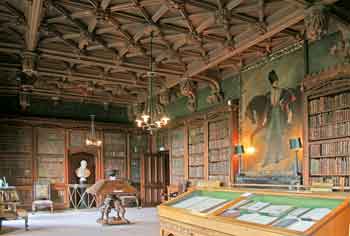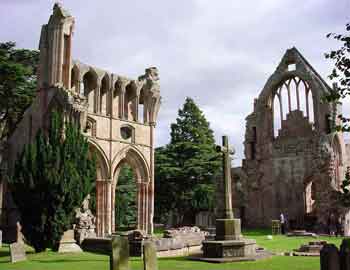Sir Walter Scott was born in College Wynd in Edinburgh’s Old Town on 15 August 1771, the tenth child of Walter Scott and Anne Rutherford.

Within a year (during the winter of 1772-3) the infant Walter contracted polio and became permanently lame in his right leg.
With no cure available, Scott was dispatched, to take the country air, at his paternal grandfather’s farm, Sandyknowe near Smailholm in the Scottish Borders.
It was 1778, before he returned to his family in Edinburgh. For Scott the transition from Sandyknowe to the rough and tumble of a larger family was hard. He later said that he felt the change, “very severely.”
High School of Edinburgh
In 1779 his parents sent him to the High School of Edinburgh where he developed a love of literature.
Illness again interrupted his life and in 1783 Scott returned to the Borders, this time to his aunt’s house in Kelso. His education continued at the local grammar school. It was here he met his future business partner James Ballantyne.
Sir Walter Scott: Edinburgh University
With his time at school complete he enrolled at Edinburgh University where he stayed from 1783 until 1786 when, with his course still incomplete, he withdrew perhaps once again because of illness. However whatever his reasons for not completing the course it wasn’t uncommon for students not to graduate.
With the world of work beckoning Walter Scott was indentured to his father to train as a solicitor. In doing so he, “Entered upon the dry and barren wilderness of forms and conveyances.”
By the spring of 1787, Scott was again seriously ill and although his subsequent recovery was slow he remained in good health for almost three decades.

Old College, University of Edinburgh
Initially, Scott’s foray into the legal world had been a depressing experience but a further stint at university in 1789 changed that.
His study of moral philosophy under Professor Dugald Stewart and Scots law under Professor David Hume, nephew of the philosopher David Hume, had a profound effect on Walter.
His views on a subject once regarded as ‘dry and dusty’ were transformed, thanks in the main to the work of Stewart and Hume.
Sir Walter Scott’s first case
He was called to the bar in 1792 but famously lost his first case defending a drunken minister before the Church of Scotland’s general assembly.
On Christmas eve 1797, Scott married Frenchwoman Charlotte Carpenter and subsequently had five children together.
The couple set up home first in George Street then South Castle Street in Edinburgh. They also had a summer home in the nearby village of Lasswade. It was here that Scott began his literary career.
Sheriff Depute of Selkirkshire
In 1799 he was appointed part-time Sheriff Depute of Selkirkshire a position which allowed him to spend around five months of the year in the Borders.
Abbotsford House

Within two years Scott had purchased Cartly Hole, a small farm on the banks of the River Tweed near Melrose in the Borders he renamed it Abbotsford House.
Scott eagerly developed his new home and by 1825 it was around ten times its original size.
Today his remarkable home is in the care of the Abbotsford Trust and is open to the public.
Over the years Scott made a number of ‘explorations’ of Scotland: the Borders, Loch Katrine and the Trossachs, Blairgowrie, Dunnottar Castle and Glamis Castle to name only a few.
In the years to come, many of his forays out of Edinburgh would provide the background and characters in his books.
Scott’s early literary works
His early literary works included translations from German but his first major work was the publication, between 1802 and 1805, of the Minstrelsy of the Scottish Borders.
Much more followed. Among the works were: Marmion (1808), Waverley novels (1814), Rob Roy (1817), Heart of Midlothian (1818, Ivanhoe (1919) and the mammoth nine volume Life of Napoleon Bonaparte (1827). Part of the research for this work involved meetings with some of the Napoleonic prisoners of war housed in Selkirk.
Scottish Crown Jewels
In a life crammed with notable events, Scott’s involvement in the rediscovery, in Edinburgh Castle, (1817) of Scotland’s crown jewels, last seen in 1707, stands out, as does the visit of King George IV to Edinburgh.
King George IV in Edinburgh
The king came to Edinburgh for two weeks in August 1822 he was the first monarch to visit Scotland since Charles II in 1651. His extraordinary visit was ‘staged managed’ by Sir Walter Scott.
More Related Content
Noted historians T.M. Devine and others have derided Scott’s attempt to present, “A gathering of the Gael” to the king.
His presumption that George wanted to see Highlanders prompted Scott to present what Devine called a, “plaided panorama based on fake Highland regalia and the mythical customs and traditions of the clans.”
Devine, writing in The Scottish Nation, argued that what the king witnessed was a, “Celtic fantasy, a distortion of the Highland past and present and the projection of a national image in which the Lowlands had no part.”

In a final flourish before the king left Scotland, Scott, after the royal procession from the Palace of Holyroodhouse to Edinburgh Castle, organised the parading of the Honours of Scotland — crown, sceptre and sword of state.
For many contemporary observers, among them J.G. Lockhart, Scott’s son-in-law and biographer, it wasn’t Walter Scott’s finest hour.
By 1825 Scott’s publishers, in which he had a financial interest, collapsed leaving significant debts.
Related reading
- Sir Walter Scott & the Writers’ Museum
Rather than declare bankruptcy and walk away Scott placed his home into a trust belonging to his creditors and spent the rest of his life trying to write his way out of debt. He never did manage this during his lifetime but posthumous income ensured that creditors were paid in full.
Following a number of strokes, Sir Walter Scott died on 21 September 1832 and was buried in Dryburgh Abbey in the Scottish Borders.
Abbotsford House Visitor Information
- For more information about Abbotsford House, the home of Sir Walter Scott visit the official website.